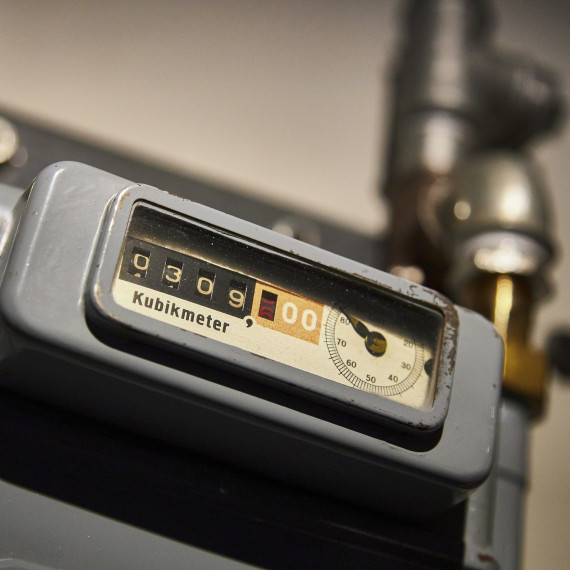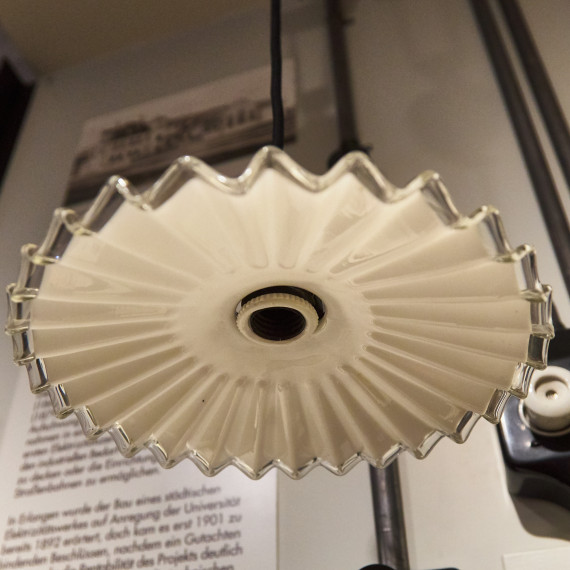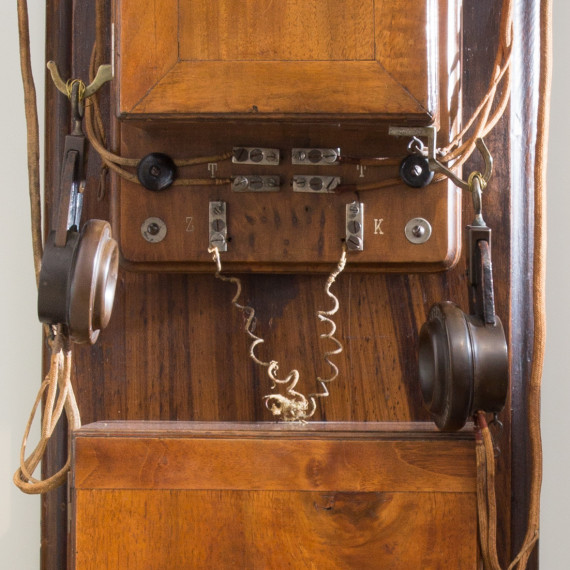Municipal utilities

The gasworks
The first gasworks in Germany were established from 1825 onwards, mainly for street lighting, which had been a public safety responsibility of municipalities. Because municipalities had not yet developed their own public services administrations at the time, they initially left the operation of gasworks to the private sector.
A gasworks was also founded in Erlangen when the gas supply network had expanded after 1850. In 1856, the first public company to form in Erlangen for this purpose was the Erlanger Gas-Gesellschaft AG ('Gas Society Ltd. Erlangen'), in which the city held a 50% stake. The Erlangen gasworks remained a public-private partnership until the town became its sole proprietor in 1893.
In contrast to neighbouring cities, Erlangen had initially opted for a supply based on wood gas. However, production was converted to the use of black coal by 1864 in order to achieve a higher gas yield. Soon, gas was not only being used for lighting, but also for cooking and heating, and as an energy source for the gas engines that were becoming available. Thanks to Auer's invention of the incandescent gas mantle, gas lighting was improved substantially, and initially remained competitive with the novel electric lighting.
Based on increased demand, and with the long-term future in mind, Erlangen's magistrate decided in 1910 to build an entirely new gasworks. Until its closure in 1962, its technical facilities had been updated several times – without any major structural changes to the building.
The sewage system
Until the second half of the 19th century, wastewater used to be discharged into the street gutters almost universally. In Erlangen, a low topographic gradient affected drainage, so that wastewater collected in the streets or slowly seeped away in cesspits. During the wetter months, the cellars of many houses often remained flooded for months on end. Faeces were collected in a pit latrine, which was often found near the buildings' water well. While Erlangen was spared the great cholera epidemics of the 19th century, typhoid cases rose here, too, around 1860.
One initial step towards sanitation was the construction of a partial sewage system in 1872-74. A sewage system covering the entire town area, however, was only built under Lord Mayor Schuh in 1882/83, in conjunction with the construction of a small waterworks on Theaterplatz, which supplied the water needed to flush the sewers. Local police regulations were issued in 1896/97 to improve pit latrines, and pneumatic evacuation of the pits was introduced.
Until the middle of the 20th century, all of the town's wastewater entered the Regnitz river via the sewage system. The current main sewage treatment plant in the Regnitz floodplain wasn't built until 1956/57, when waste volumes had continued to increase in step with Erlangen's rapid growth after 1945.
The waterworks
Before the introduction of a centralised water supply, the town's population obtained the water they required for drinking and other uses from groundwater-fed wells. More than 50 public, as well as numerous private courtyard wells existed in Erlangen at the time.
The water supply situation had deteriorated considerably since the middle of the 19th century, as water use and groundwater pollution rose with the growth of the town and increasing economic activity.
A first improvement occurred in 1883/84 in conjunction with the construction of the sewerage system. A waterworks was erected on Theaterplatz, which served as a drinking water supply, fire-fighting reserve, and to flush the sewage system. Only public buildings and wells were connected to its short network of pipes.
In 1890/91, on the initiative of Lord Mayor Schuh, a waterworks with a substantially larger capacity was constructed in an area with access to groundwater west of the river Regnitz, representing the town’s first centralised water supply system. It initially comprised a pumping station with two steam engines, two suction and pressure pumps, six filtering wells, an elevated reservoir on the Burgberg ('castle hill'), and 17.3 km of pipes in its network. By 1899, almost all houses in the town had been connected to the drinking water supply.

The electric power plant
The invention of the Siemens dynamo machine (1866) and Edison's coal filament lamp (1879) created the conditions for an upswing in the electric power industry. In 1885, the first central power stations began operating in several large German cities in order to satisfy industry's demand for electricity for lighting and electric motors, or to enable the introduction of electric trams.
The construction of a municipal electric power station had already been discussed in Erlangen at the suggestion of the university in 1892, but binding decisions weren't taken until 1901, after a report by the gasworks had demonstrated the project's economic credentials. The contract for its technical equipment was awarded to local company Reiniger, Gebbert, and Schall. A 2 x 220-volt DC system was chosen. It began operations in 1902, supplying 111 connected households.
Soon, growing electricity consumption led to an increase in power generation capacity, and finally to an external supply provided by large-scale, transregional power stations. In 1919, the municipality acquired the Werker hydroelectric power plant with the intention to expand it in subsequent years. This plant also provided three-phase current to Erlangen for the first time. In 1924, Erlangen was connected to the long-distance transmission lines of the Überlandwerk Oberfranken ('Upper Franconia Overland Facility') via the joint network of the Regnitzstromverwertung AG (RSV, the 'Regnitz Electricity Utilisation Ltd.').
Today, Erlangen only generates around 10 percent of its electricity demand. A large proportion of electricity imports are still obtained from Energieversorgung Oberfranken ('Upper Franconia Energy Supply') via the RSV.

The telephone
The industrial revolution led to a growing need for fast communications, and consequently also to rapid progress in communication technology. First pioneering achievements arrived in the field of telegraphy – the electrical transmission of signals. In 1848/49, the first European long-distance telegraph line was established between Berlin and Frankfurt on the Main by the Siemens & Halske company. Towards the end of the 19th century, the telegraph had expanded to become a global communications network.
The second – and fundamental – innovation was the telephone. Thanks to inventions by Philipp Reis (1861), Graham Bell (1876), and David Hughes (1878), the human voice, too, could now been transmitted electrically. In contrast to the telegraph, the developing telephone technology was not so much concerned with connecting vastly distant locations, but rather with an at first spatially limited network of many individual participants. Only after 1900 could telephone calls also be transmitted over long distances.
In Germany, telephone services were – following the model of the telegraph – developed under the auspices of the state. In 1881, the first telephone exchange opened in Berlin, and the first local Bavarian network was commissioned in Ludwigshafen a year later.
Erlangen's local telephone network opened in 1891 with four subscribers. During its first decades, the circle of subscribers was to a large extent limited to the business sector and public institutions. Only in the 1950s did the telephone become a common means of communication. In 1991, one hundred years after the introduction of the telephone in Erlangen, the local network consisted of around 62,500 customers.
